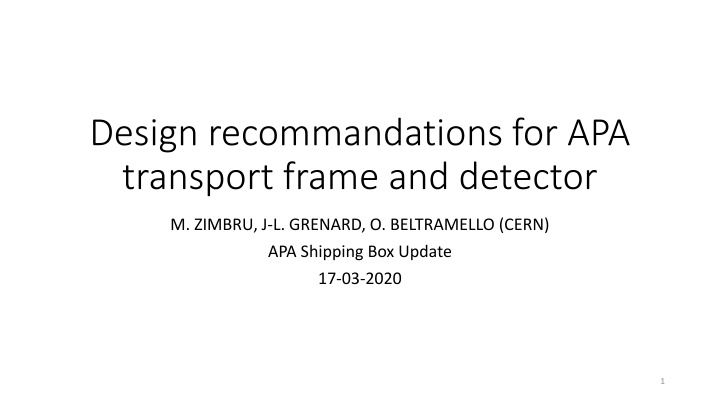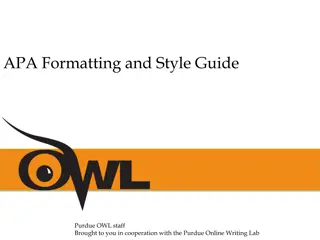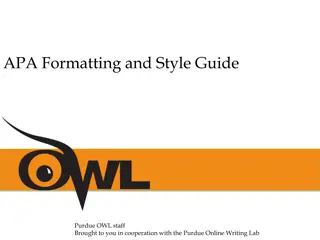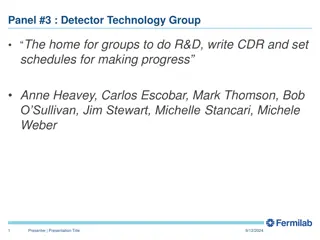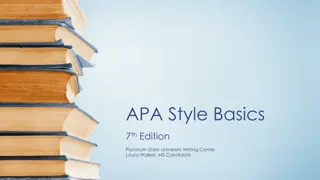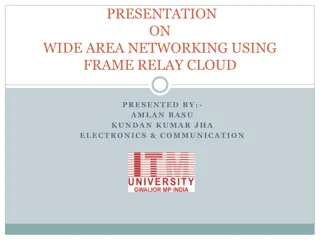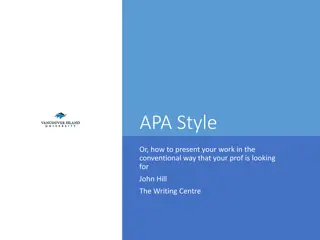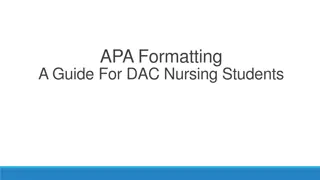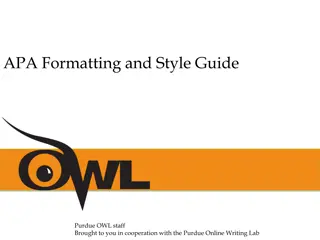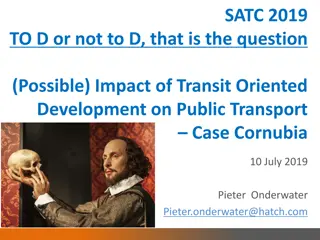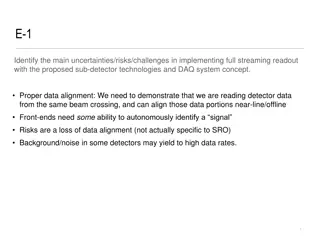Design Recommendations for APA Transport Frame and Detector
This document outlines design requirements and proposals for the transportation of the APA detector and frame under various load cases, covering static and dynamic structural calculations, transportation conditions, and regulations related to transport inside the Ross Shaft mine elevator. It emphasizes the need for careful consideration of forces acting on connections during transport phases.
Download Presentation

Please find below an Image/Link to download the presentation.
The content on the website is provided AS IS for your information and personal use only. It may not be sold, licensed, or shared on other websites without obtaining consent from the author.If you encounter any issues during the download, it is possible that the publisher has removed the file from their server.
You are allowed to download the files provided on this website for personal or commercial use, subject to the condition that they are used lawfully. All files are the property of their respective owners.
The content on the website is provided AS IS for your information and personal use only. It may not be sold, licensed, or shared on other websites without obtaining consent from the author.
E N D
Presentation Transcript
Design recommandations for APA transport frame and detector M. ZIMBRU, J-L. GRENARD, O. BELTRAMELLO (CERN) APA Shipping Box Update 17-03-2020 1
Contents Contents Design requirements proposal from CO Design of the APA transport frame + APA detector for transport conditions Transportation inside the Ross shaft Quasi-static load cases One additional concern Air transportation Dynamic load cases - aspects related to vibrations and shocks Specification for the transport between various sites of productions 2
Design requirements proposal from CO Design requirements proposal from CO In general, memorandum EDMS No: 2330505 should be fulfilled. The load cases considered in the static and dynamic structural calculations for the APA detector, the APA frame and all assembly structures and connections should cover: - all static load cases related to manipulation, installation and operation (not the purpose of this talk, to be detailed in the analysis plan). - load cases related to the transport inside the Ross shaft (see page 2 and 3). - load cases related to transport of the APA + APA frame assembly by road and by boat. Notes: 1. For the moment the transport by plane is not envisaged. This has to be clarified by the project. In case of transport by plane, higher levels of quasi- static load requirements would need to be applied (see slide 9). 2. By APA frame we mean all the structures in between the truck and the connection with the APA, wire rope absorber included. 3
Design of the APA transport frame + APA detector for all load cases Design of the APA transport frame + APA detector for all load cases We expect a check of the assembly structure of APA Frame + wire rope absorbers + APA detector following the agreed standards Definition of the forces acting on the connection between the various elements during the transport phases APA -> APA fixation system APA -> wire rope absorbers Wire rope absorbers -> APA transport frame 4
Regulations related to transport inside Ross Shaft mine elevator Regulations related to transport inside Ross Shaft mine elevator Nova Scotia Mining Regulation: https://novascotia.ca/just/regulations/regs/ohsmine.htm#TOC2_305 Free fall test of cage 359 MSHA standard Subpart R Personnel Hoisting Hoisting procedure Page 346 - 418 A free fall test for a cage is successfully passed if all of the following conditions are met: (a) least 9 m/s and not faster than 20 m/s ; the cage decelerates to a stop at an average rate of at (b) mechanisms; there is no damage to the safety catches and (c) during deceleration. the safety catches engage the guides continuously Therefore: The rate of 20 m/s2is 2.04g. Essentially, the final test results must fall between 9 and 20 m/s2which is about 0.9 to 2.04g For info: Normal operation: 6ft/s2 -> 1.8m/s2 -> ~0.19g Emergency braking: 16ft/s2 -> 4.87m/s2 -> ~0.5g 5
Proposal of load cases related to the transport inside the Ross shaft Proposal of load cases related to the transport inside the Ross shaft 1. To be conservative, we propose: Maximum acceleration and deceleration is 1g of the APA frame + APA i.e. the APA frame + APA should meet the standards for this load case. 2. In case of major failure, like hoist cable breakage, we can have up to 2g. This case is considered extremely unlikely and cannot be used as a design case. We request that the APA frame will not reach ultimate strength in case of 2g deceleration, which means that some local plasticity is acceptable. This effect has to be demonstrated and considered as an exceptional case and not as a normal case. For a maximum acceleration/deceleration of 2g of the APA frame + APA, plastic deformations are accepted, but none of the structure of connection should reach Ultimate. This load case is considered exceptional (safety factors should be adapted, see regulations). 6
Design of the transport frame + APA detector for transport conditions Design of the transport frame + APA detector for transport conditions quasi quasi- -static static load load cases cases IMO/ILO/UNECE Code of Practice for Packing of Cargo Transport Units 7
Design of the transport frame + APA detector for transport conditions Design of the transport frame + APA detector for transport conditions quasi quasi- -static static load load cases cases Using CTU we are compliant with: CFR Title 49 - Transportation -> same values 8
One additional concern One additional concern Air transportation Air transportation Data from Lufthansa insurance expert https://www.tis-gdv.de/tis_e/misc/mechanisch.htm/ This seems to be the worst case in term of accelerations Does this have to be considered? 9
Design of the transport frame + APA detector for transport conditions Design of the transport frame + APA detector for transport conditions quasi quasi- -static load cases static load cases Summary: Z vertical Y - longitudinal X - transversal Quasi- static load cases - transport X transversal Y longitudinal Z vertical Load case 1 (road)- CTU 0.8 g / -0.5 g - - 1 g (road) -1 g (gravity) Load case 2 (road)- CTU - 0.5 g - 1 g (road) -1 g (gravity) Load case 3 (sea)- CTU 0.8 g - 1 g (road) -1 g (gravity) Load case 4 (road)- CFR Title 49 0.8 g / - 0.5 g 0.5 g - 1g (gravity) 10
Dynamic load cases Dynamic load cases - - aspects related to vibrations and shocks aspects related to vibrations and shocks The dynamic analyses of the APA detector inside the APA frame should be analysed in 3 steps 1. Modal analysis: A modal analysis is required to check the decoupling of the APA detector and the APA frame. Required: Eigenfrequencies + principal modal masses in the 3 directions of the APA detectors constrained at his interface with the APA frame. The calculation should be run from 0 to 100 Hz or at least until we reach 90 % of the total mass. Eigenfrequencies + principal modal masses in the 3 directions of the APA frame + attenuator constrained at his interface with the truck. APA mass is modelled as a single mass at COG. The calculation should be run from 0 to 100 Hz or at least until we reach 90 % of the total mass. Eigenfrequencies + principal modal masses in the 3 directions of the APA frame + attenuator + APA detector constrained at his interface with the truck. The calculation should be run from 0 to 100 Hz or at least until we reach 90 % of the total mass. The attenuator stiffness in all 3 direction are mandatory for these analyses. 11
Dynamic load cases Dynamic load cases - - aspects related to vibrations and shocks aspects related to vibrations and shocks 2. Dynamic response analysis Sine type of vibrations. A dynamic response analysis is required to check the maximum amplifications, loads, stresses and deformations at the level of the APA frame and the APA detector (connections and wires). All the structural elements and connections and wires should be assessed with the maximum loads extracted from these calculations. This calculation will also check the efficiency of the attenuator on sine type of vibrations coming from the road transport. The dynamic response should be run with the dynamic response spectrum provided in page XX. The attenuator damping factor and stiffness in all 3 direction are mandatory for these analyses. 3. Shock type of vibrations. See page XX. The type of calculations for shock input or tests are to be discussed with the company. 12
Dynamic load cases Dynamic load cases - - aspects related to vibrations and shocks aspects related to vibrations and shocks MIL STD 810H Test methods standard Data from MIL standard are relevant according to APA SBND transport (blue curve) -> the data could be considered as input for the Wire rope absorbers specification SBND Recorded Transport data Longitudinal Vertical Transverse 13
Dynamic load cases Dynamic load cases - - aspects related to vibrations and shocks aspects related to vibrations and shocks Technical specification of the wire rope absorbers Definition of type of absorbers Quantity of absorbers Definition of natural frequencies of absorbers Damping effect between wide range of acceleration (shocks) How sensitive is the APA to vibration? (screws tightening, connectors, wire connections ) How will the wire rope absorber attenuate vibrations? Is the rope absorber designed to attenuate the shock type (>100 Hz) or sine type (0-100Hz) ? 14
Specification for the transport between various sites of productions Specification for the transport between various sites of productions To be included in the specification for the transport Truck + trailer with air suspension Rubber pad with a minimum thickness of 10mm between the transport box and the trailer Rubber pad with a minimum thickness of 10mm between the APA transport frame and the transport box Package secured on truck, ship according to CTU or CFR title 49 standard 15
Ross Ross Shaft Shaft Current Current operating conditions operating conditions For info: 1ft/s2 -> 0.3m/s2 -> ~0.03g 2.07ft/s2 -> 0.63m/s2-> ~0.06g 17
NASA Space vehicle Design criteria. Transportation and handling loads NASA Space vehicle Design criteria. Transportation and handling loads Observations Constant Peak g, limit load factors Values obtained based on experience with transportation of fragile cargo Doesn t account for the cumulative effect of repeated loads if varying amplitudes Used in preliminary design of unique/expensive equipment Road sources of vibrations: road irregularities, starting, stopping, turning, docking, wind 18
